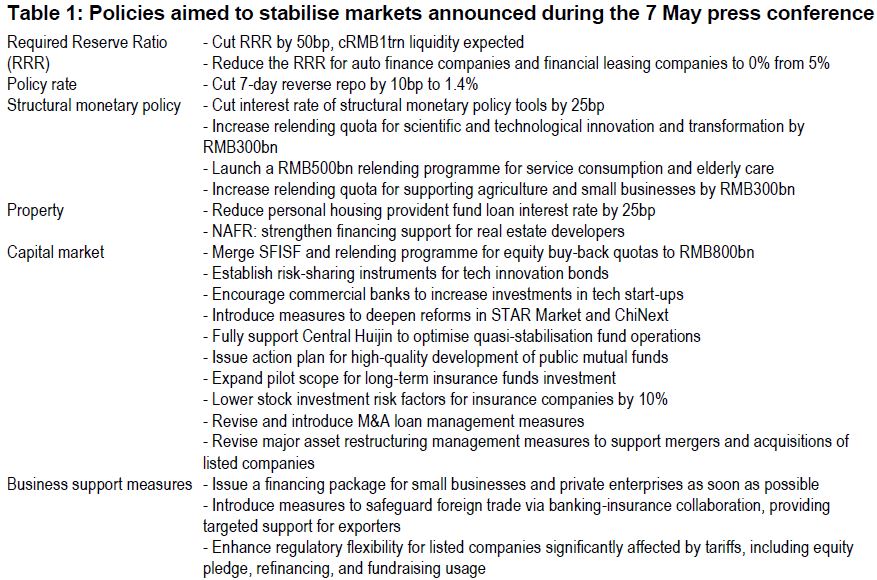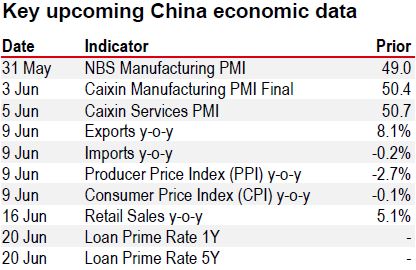
20 May 2025
Following the pro-growth stance denoted in the April Politburo meeting, the heads of the People’s Bank of China (PBoC), the National Financial Regulatory Administration (NFRA) and the China Securities Regulatory Commission (CSRC) held a press conference on 7 May to roll out financial market stabilisation measures (Table 1). The package, however, did not include direct fiscal support for domestic consumption, in line with our view that China will focus on implementing various fiscal easing already announced during the National People’s Congress in early March.
Numerous monetary easing measures were rolled out, including lowering the policy rate by 10bp, structural relending rates by 25bp (from 1.75% to 1.5%) and the Pledged Supplementary Lending rate by 25bp (from 2.25% to 2%). Liquidity injections included an outright 50bp cut in the required reserve ratio (equivalent to a RMB1trn liquidity injection) and creation of several new monetary policy tools. If fully utilised, the new tools add an additional RMB2.1trn of liquidity to the real economy. We think more easing will follow, likely through additional rate cuts in the second half of the year and the PBoC resuming treasury purchases from the secondary market.
The CSRC emphasised that market stability is critical to economic growth and the interests of investors, while pledging support for Central Huijin to play the important role as a market stabiliser. There has been a substantial change in policy stance towards the stock market since 24 September 2024, with ‘stock market (and housing) stabilisation’ written into this year’s target. Indeed, Central Huijin announced purchases of A-share ETFs in early April when the trade escalations shocked the market (Securities Times, 8 April); however, this is the first time the CSRC has referred to it as the quasi-market stabilisation fund.
The NFRA also announced that it would lower risk factors for insurance companies to increase equity exposure, encouraging more ‘patient capital’ to make stock investments.
The three ministries consistently pledged support for the real economy. The PBoC’s new monetary tools are aimed at directing new funds towards technology innovation, expanding elderly care and supporting small businesses. The CSRC is prioritising reforms to provide capital support for technology innovation, while enhancing investor protection to increase market reliability. And the NFRA is focusing on financing support for real estate developers, exporters and importers, and adapting regulations to help industrial transformation and upgrading.
Though not a focus of the press conference, we think reviving consumption remains the primary policy target this year. The Labour Day holiday showed improving activity, but we stay cautious as outcomes of tariff negotiations remain highly uncertain, while negative impacts may just be starting to unfold. A mix of both near-term measures, like trade-in programmes and services consumption subsidies, as well as structural measures, such as improved social safety net coverage, pension reforms and stabilisation of the housing sector, will likely be rolled out.
China and the US announced a tentative trade truce in Geneva on 12 May, agreeing to suspend new tariffs for 90 days and scale back existing tariffs (China to face 30%, the US to face 10%). Both sides agreed to establish a ‘consultation mechanism for trade and economic issues’, laying the groundwork for future high-level dialogue. The pullback will be most welcomed by businesses on both sides that were starting to feel the pinch from reciprocal tariffs and presents upside risks to economic growth.

Source: SCIO, HSBC

Source: LSEG Eikon

*Past performance is not an indication of future returns
Source: LSEG Eikon. As of 16 May 2025, market close





Additional disclosures
1. This report is dated as at 19 May 2025.
2. All market data included in this report are dated as at close 19 May 2025, unless a different date and/or a specific time of day is indicated in the report.
3. HSBC has procedures in place to identify and manage any potential conflicts of interest that arise in connection with its Research business. HSBC's analysts and its other staff who are involved in the preparation and dissemination of Research operate and have a management reporting line independent of HSBC's Investment Banking business. Information Barrier procedures are in place between the Investment Banking, Principal Trading, and Research businesses to ensure that any confidential and/or price sensitive information is handled in an appropriate manner.
4. You are not permitted to use, for reference, any data in this document for the purpose of (i) determining the interest payable, or other sums due, under loan agreements or under other financial contracts or instruments, (ii) determining the price at which a financial instrument may be bought or sold or traded or redeemed, or the value of a financial instrument, and/or (iii) measuring the performance of a financial instrument or of an investment fund.
This document is prepared by The Hongkong and Shanghai Banking Corporation Limited (‘HBAP’), 1 Queen’s Road Central, Hong Kong. HBAP is incorporated in Hong Kong and is part of the HSBC Group. This document is distributed by HSBC Continental Europe, HBAP, HSBC Bank (Singapore) Limited, HSBC Bank (Taiwan) Limited, HSBC Bank Malaysia Berhad (198401015221 (127776-V))/HSBC Amanah Malaysia Berhad (200801006421 (807705-X)), The Hongkong and Shanghai Banking Corporation Limited, India (HSBC India), HSBC Bank Middle East Limited, HSBC UK Bank plc, HSBC Bank plc, Jersey Branch, and HSBC Bank plc, Guernsey Branch, HSBC Private Bank (Suisse) SA, HSBC Private Bank (Suisse) SA DIFC Branch, HSBC Private Bank Suisse SA, South Africa Representative Office, HSBC Financial Services (Lebanon) SAL, HSBC Private banking (Luxembourg) SA and The Hongkong and Shanghai Banking Corporation Limited (collectively, the “Distributors”) to their respective clients. This document is for general circulation and information purposes only. This document is not prepared with any particular customers or purposes in mind and does not take into account any investment objectives, financial situation or personal circumstances or needs of any particular customer. HBAP has prepared this document based on publicly available information at the time of preparation from sources it believes to be reliable but it has not independently verified such information. The contents of this document are subject to change without notice. HBAP and the Distributors are not responsible for any loss, damage or other consequences of any kind that you may incur or suffer as a result of, arising from or relating to your use of or reliance on this document. HBAP and the Distributors give no guarantee, representation or warranty as to the accuracy, timeliness or completeness of this document. This document is not investment advice or recommendation nor is it intended to sell investments or services or solicit purchases or subscriptions for them. You should not use or rely on this document in making any investment decision. HBAP and the Distributors are not responsible for such use or reliance by you. You should consult your professional advisor in your jurisdiction if you have any questions regarding the contents of this document. You should not reproduce or further distribute the contents of this document to any person or entity, whether in whole or in part, for any purpose. This document may not be distributed to any jurisdiction where its distribution is unlawful.
The following statement is only applicable to HSBC Bank (Taiwan) Limited with regard to how the publication is distributed to its customers: HSBC Bank (Taiwan) Limited (“the Bank”) shall fulfill the fiduciary duty act as a reasonable person once in exercising offering/conducting ordinary care in offering trust services/business. However, the Bank disclaims any guaranty on the management or operation performance of the trust business.
The following statement is only applicable to by HSBC Bank Australia with regard to how the publication is distributed to its customers: This document is distributed by HSBC Bank Australia Limited ABN 48 006 434 162, AFSL/ACL 232595 (HBAU). HBAP has a Sydney Branch ARBN 117 925 970 AFSL 301737.The statements contained in this document are general in nature and do not constitute investment research or a recommendation, or a statement of opinion (financial product advice) to buy or sell investments. This document has not taken into account your personal objectives, financial situation and needs. Because of that, before acting on the document you should consider its appropriateness to you, with regard to your objectives, financial situation, and needs.
Important Information about the Hongkong and Shanghai Banking Corporation Limited, India (“HSBC India”)
HSBC India is a branch of The Hongkong and Shanghai Banking Corporation Limited. HSBC India is a distributor of mutual funds and referrer of investment products from third party entities registered and regulated in India. HSBC India does not distribute investment products to those persons who are either the citizens or residents of United States of America (USA), Canada or New Zealand or any other jurisdiction where such distribution would be contrary to law or regulation.
Mainland China
In mainland China, this document is distributed by HSBC Bank (China) Company Limited (“HBCN”) and HSBC FinTech Services (Shanghai) Company Limited to its customers for general reference only. This document is not, and is not intended to be, for the purpose of providing securities and futures investment advisory services or financial information services, or promoting or selling any wealth management product. This document provides all content and information solely on an "as-is/as-available" basis. You SHOULD consult your own professional adviser if you have any questions regarding this document.
The material contained in this document is for general information purposes only and does not constitute investment research or advice or a recommendation to buy or sell investments. Some of the statements contained in this document may be considered forward looking statements which provide current expectations or forecasts of future events. Such forward looking statements are not guarantees of future performance or events and involve risks and uncertainties. Actual results may differ materially from those described in such forward-looking statements as a result of various factors. HSBC India does not undertake any obligation to update the forward-looking statements contained herein, or to update the reasons why actual results could differ from those projected in the forward-looking statements. Investments are subject to market risk, read all investment related documents carefully.
© Copyright 2025. The Hongkong and Shanghai Banking Corporation Limited, ALL RIGHTS RESERVED.
No part of this document may be reproduced, stored in a retrieval system, or transmitted, on any form or by any means, electronic, mechanical, photocopying, recording or otherwise, without the prior written permission of The Hongkong and Shanghai Banking Corporation Limited.
Important information on sustainable investing
“Sustainable investments” include investment approaches or instruments which consider environmental, social, governance and/o r other sustainability factors (collectively, “sustainability”) to varying degrees. Certain instruments we include within this category may be in the process of changing to deliver sustainability outcomes.
There is no guarantee that sustainable investments will produce returns similar to those which don’t consider these factors. Sustainable investments may diverge from traditional market benchmarks.
In addition, there is no standard definition of, or measurement criteria for sustainable investments, or the impact of sustainable investments (“sustainability impact”). Sustainable investment and sustainability impact measurement criteria are (a) highly subjective and (b) may vary significantly across and within sectors.
HSBC may rely on measurement criteria devised and/or reported by third party providers or issuers. HSBC does not always conduct its own specific due diligence in relation to measurement criteria. There is no guarantee: (a) that the nature of the sustainability impact or measurement criteria of an investment will be aligned with any particular investor’s sustainability goals; or (b) that the stated level or target level of sustainability impact will be achieved.
Sustainable investing is an evolving area and new regulations may come into effect which may affect how an investment is categorised or labelled. An investment which is considered to fulfil sustainable criteria today may not meet those criteria at some point in the future.